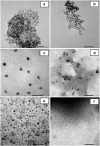Synthesis of silica nanoparticles from Vietnamese rice husk by sol-gel method
- PMID: 23388152
- PMCID: PMC3606399
- DOI: 10.1186/1556-276X-8-58
Synthesis of silica nanoparticles from Vietnamese rice husk by sol-gel method
Abstract
Silica powder at nanoscale was obtained by heat treatment of Vietnamese rice husk following the sol-gel method. The rice husk ash (RHA) is synthesized using rice husk which was thermally treated at optimal condition at 600°C for 4 h. The silica from RHA was extracted using sodium hydroxide solution to produce a sodium silicate solution and then precipitated by adding H2SO4 at pH = 4 in the mixture of water/butanol with cationic presence. In order to identify the optimal condition for producing the homogenous silica nanoparticles, the effects of surfactant surface coverage, aging temperature, and aging time were investigated. By analysis of X-ray diffraction, scanning electron microscopy, and transmission electron microscopy, the silica product obtained was amorphous and the uniformity of the nanosized sample was observed at an average size of 3 nm, and the BET result showed that the highest specific surface of the sample was about 340 m2/g. The results obtained in the mentioned method prove that the rice husk from agricultural wastes can be used for the production of silica nanoparticles.
Figures









References
-
- Chandra S. Waste Materials Used in Concrete Manufacturing. Westwood: Noyes; 2007.
-
- Hwang CL, Wu DS. In: ACI SP-114: Fly Ash, Silica Fume, Slag, and Natural Pozzolans in Concrete. Malhotra VM, editor. Farmington Hills: American Concrete Institute; 1989. Properties of cement paste containing rice husk ash; pp. 733–765.
-
- Lin KM. The study on the manufacture of particle-board made of China fir flakes and hulls. Master thesis. National Chung-Hsing University; 1975.
-
- Abu Bakar BH, Putrajaya R, Abdulaziz H. Malaysian rice husk ash - improving the durability and corrosion resistance of concrete: pre-review. Concr Res Lett. 2010;1(1):6–13.
-
- Real C, Alcala D, Maria C, Jose M. Preparation of silica from rice husks. J Am Ceram Soc. 2008;79(8):2012–2016.
LinkOut - more resources
Full Text Sources
Other Literature Sources
Research Materials
Miscellaneous

